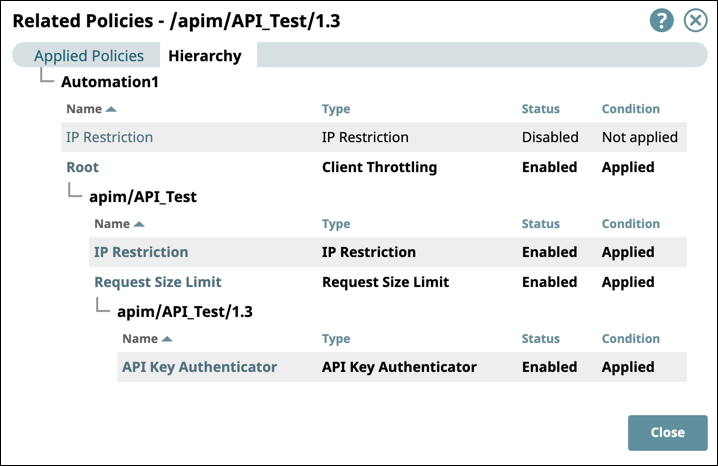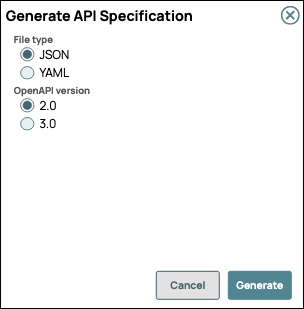In this article
Overview
The Version Details page is the space where you can view information about a version of the API, the assets it contains, and permissions. Besides performing all lifecycle actions for an API published on the API Portal, you can manage API policies for the API version. You can also manage the specification file referenced by the version. SnapLogic APIM supports both JSON and YAML formats for specification files. Both OAS 2.0 and OAS 3.0 specification types are supported.
To navigate the Version Details page:
In the API Manager, click the API name.
Go to the Versions tab.
Click the version number of the API version you want.
Supported UI Operations
On the Version Details page, you can do the following operations:

For details about the assets used in the API version, see Managing API Version Assets.
Viewing API Policy Information
To view the API policies applied at the various levels for an API version,
In the Version Details tab of the API version dialog, click View Applied Policies to display the Related Policies dialog.
In the Applied Policies tab, the following information is displayed:

Name: The name entered in the Label field for the API policy. Click the name to display the Settings dialog for that API policy.
Type: The type of the policy.
Path: The path of the policy.
Go to the Hierarchy tab to view the level (Org, API, version) where the API policy is applied.

Click Close to return to the Version Details tab.
You can add and delete policies from the Version Details page.
Editing Version Details
You can edit the description and tags for an API Version without republishing the API. You can also change the Snaplex if the API version is unpublished.
Navigate to the target API, and click the version to edit.
Click Edit Details, and update the following fields:
Description
Tags
Generate the Specification for your API
For your specification to be valid, the Tasks in your API Version and all associated assets must be valid. When you generate the API specification from a Task or Pipeline that is not valid, the UI displays an error message. |
To enable your API Consumers to download the API specification used in the API version published in the Developer Portal:
Click Generate Spec.
In the Generate API Specification dialog, select from the following options:

File type. Choose from one of the two following options:
JSON
YAML
OpenAPI version. Choose from one of the two following options:
2.0
3.0
Click Generate. The following message appears:
API Specification generated per the modifications made to the API implementation.
The generated specification is in the Open API Specification (OAS) format, and the API consumer can examine its contents when viewing the API’s documentation in the Developer Portal.
Version Details Reference
Created: The date when the API is created.
Owner: The user who owns the Asset. Typically, the owner inherits the asset when it is moved or the creator is no longer a user in the Org.
Updated: The time the API Version is last updated.
Versions: The status of the API version.
Policy: The policies applied to the API Version. Click the policy name to display the policy’s Settings dialog.
Type: The type of the API policy.
Owner: The owner of the API policy.
Update: The time that the API policy is last updated.
Status: Indicates if the API policy is Enabled or Disabled. You can enable or disable an API policy in the policy’s Settings dialog.
Description: The API’s description, which is added during the creation of the API or the API Version.
Tags: Metadata added to the API and API version.
Troubleshooting Spec Generation Errors
Use the following table to troubleshoot errors when you generate specifications from your API Versions.
Error | Reason | Resolution |
|---|---|---|
| The pipeline for the API Version is configured to run an error pipeline, the API version is missing the required Tasks. | Add the required Triggered or Ultra Tasks to the Assets folder for your API Version. |
| The Snaplex specified in the API Version details does not have nodes. | Navigate to the Versions tab and specify a Snaplex with nodes from the global |
| The API Version has the required Tasks, but the Tasks do not specify a pipeline. | Add or create a pipeline for your Task. |
| The specification for the API Version has an invalid reference: for example, a non existent expression library. | Fix the reference, then upload and generate it. |